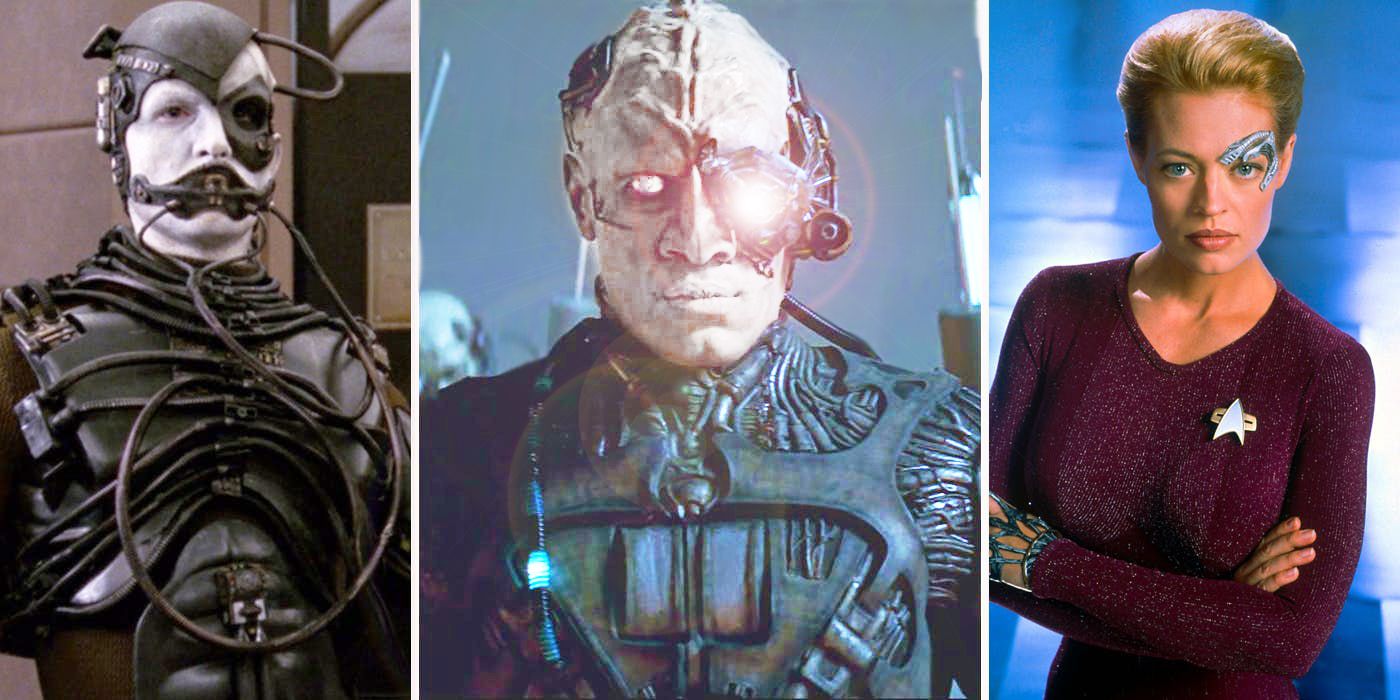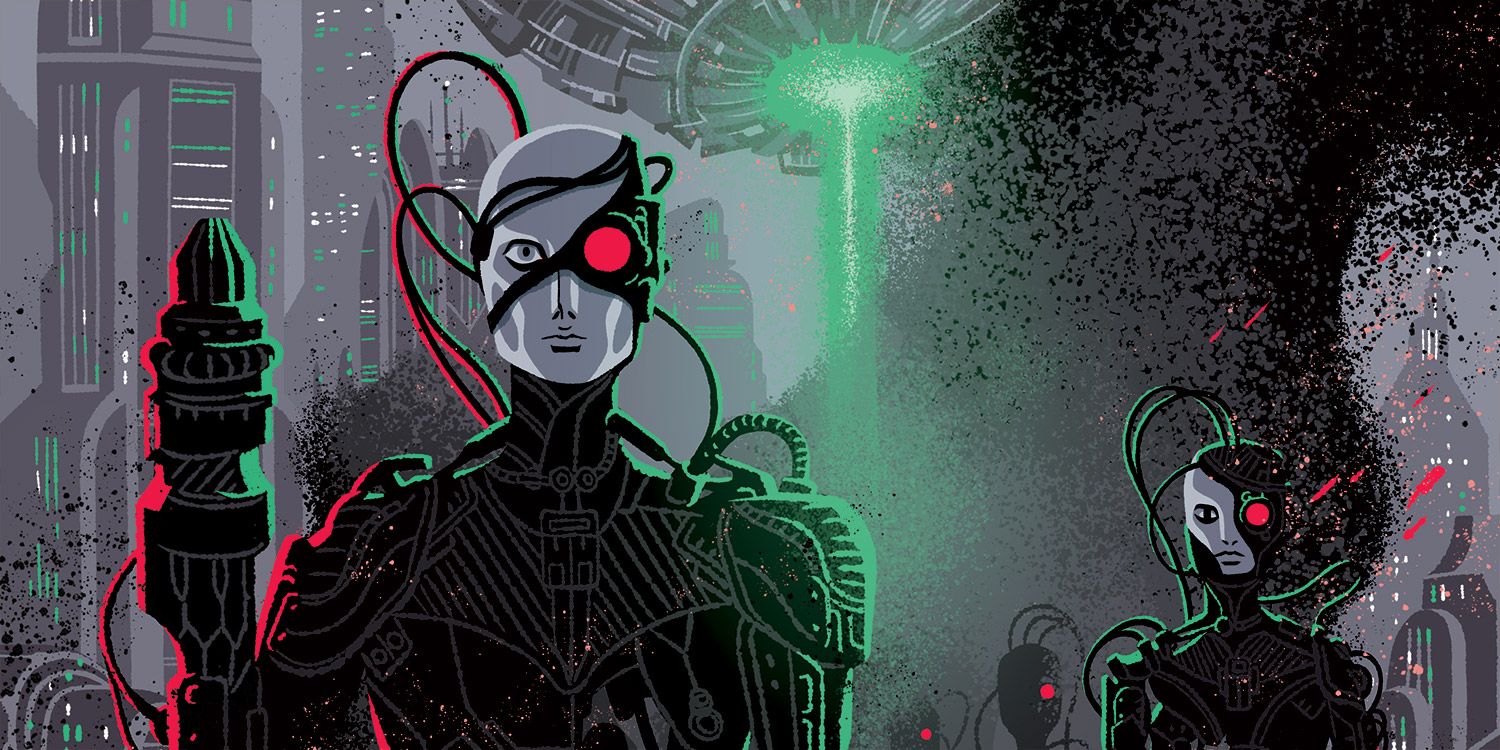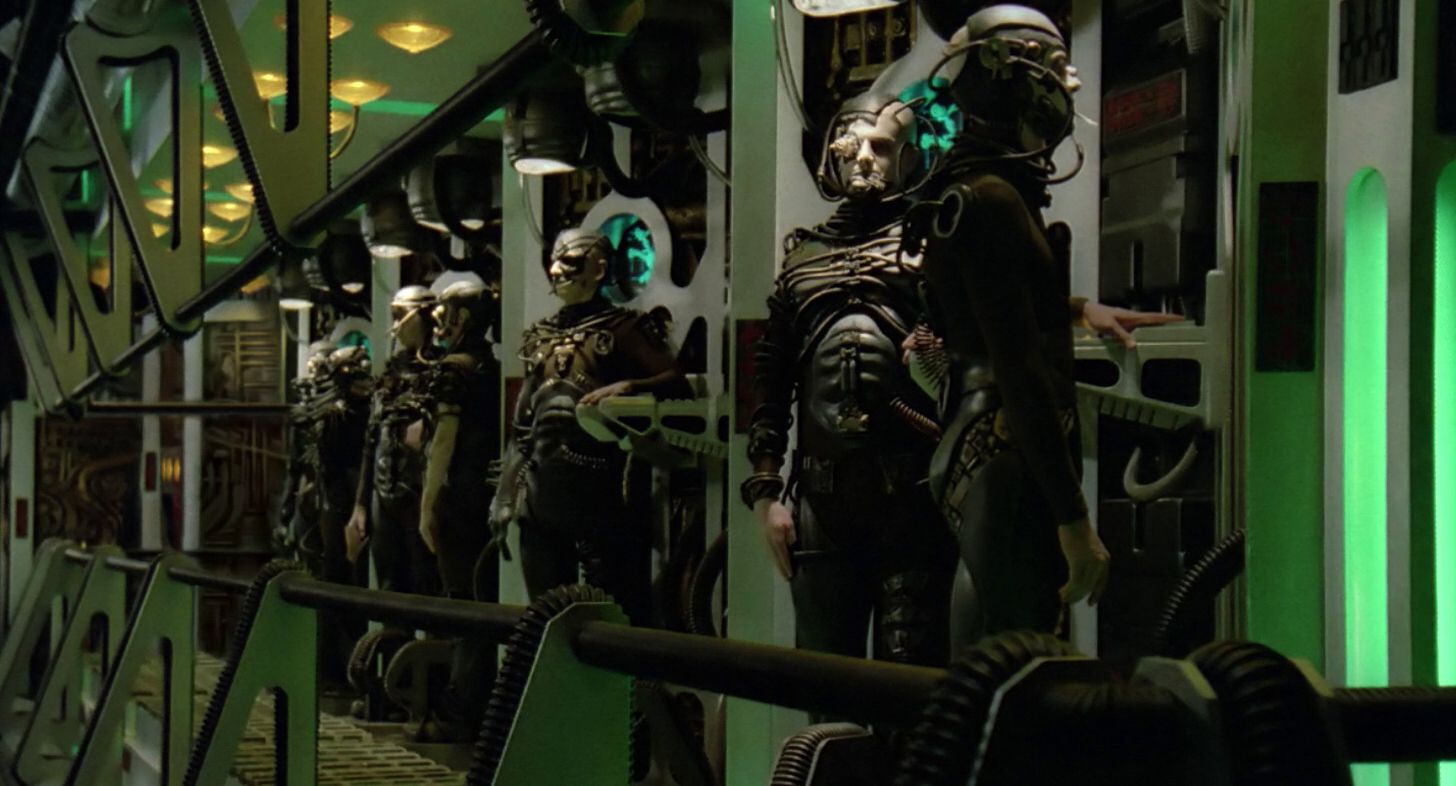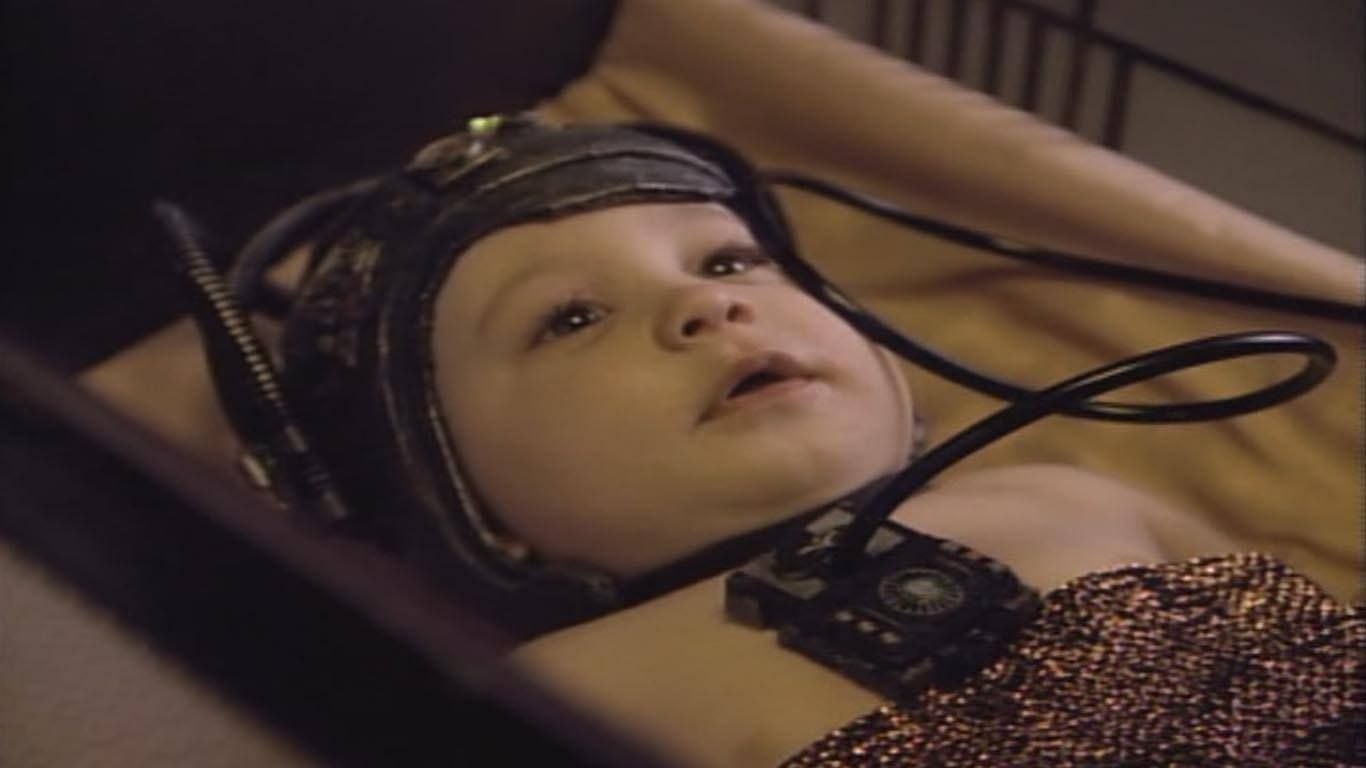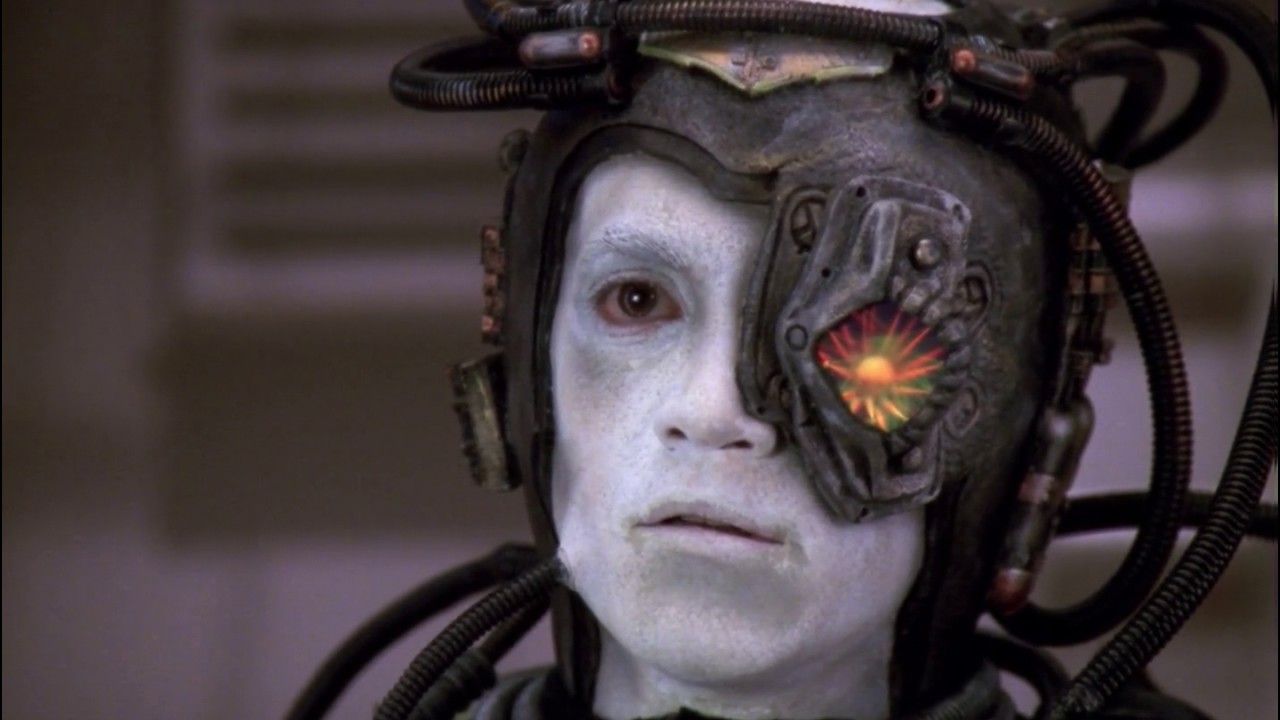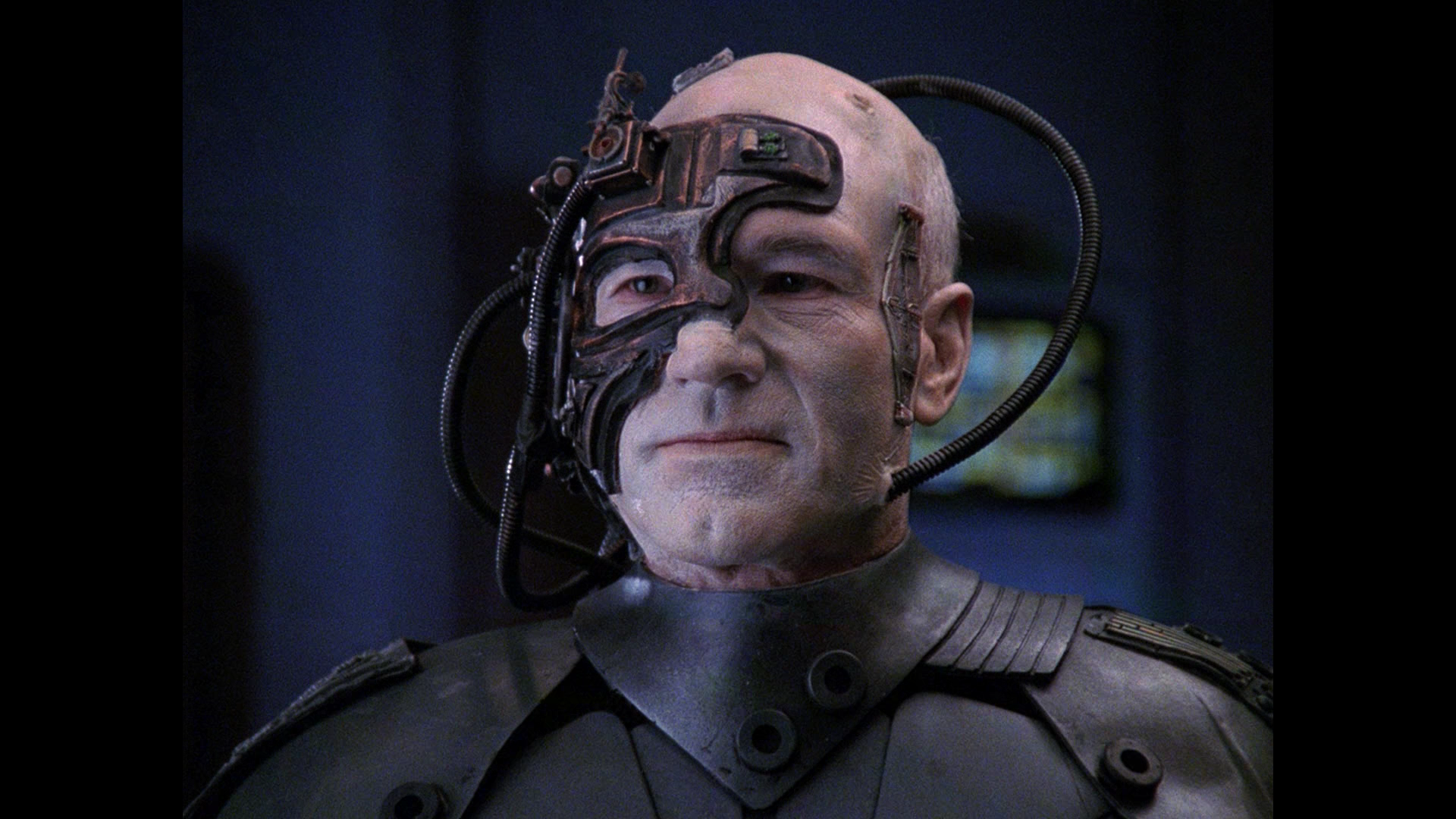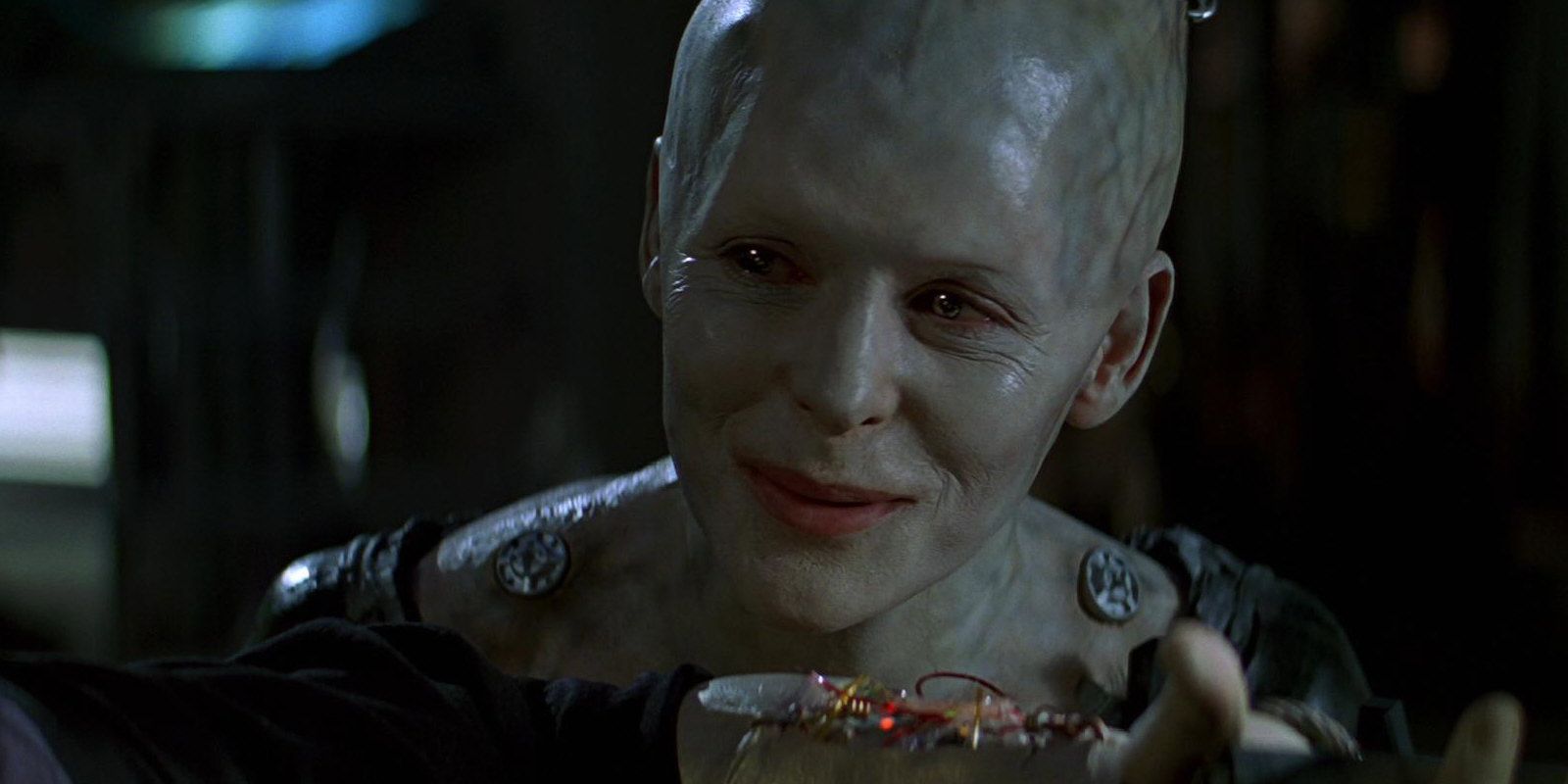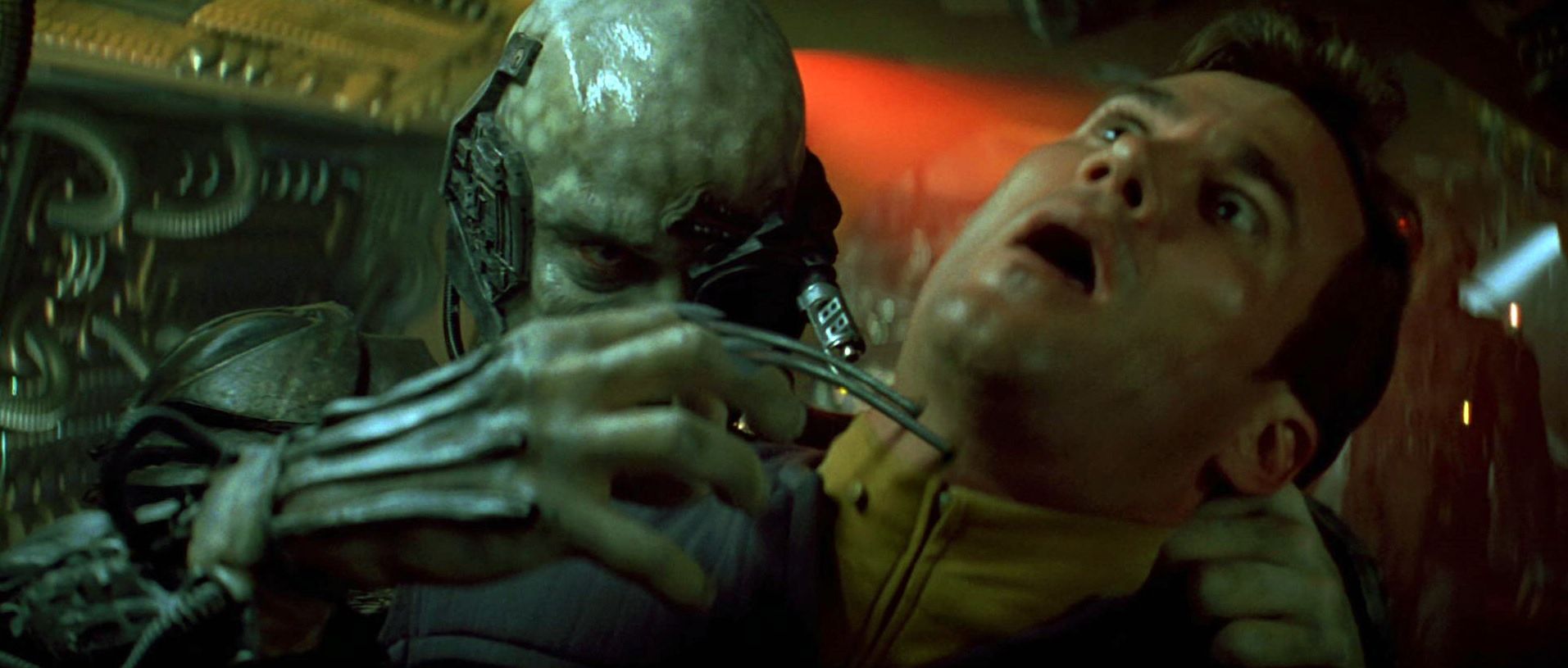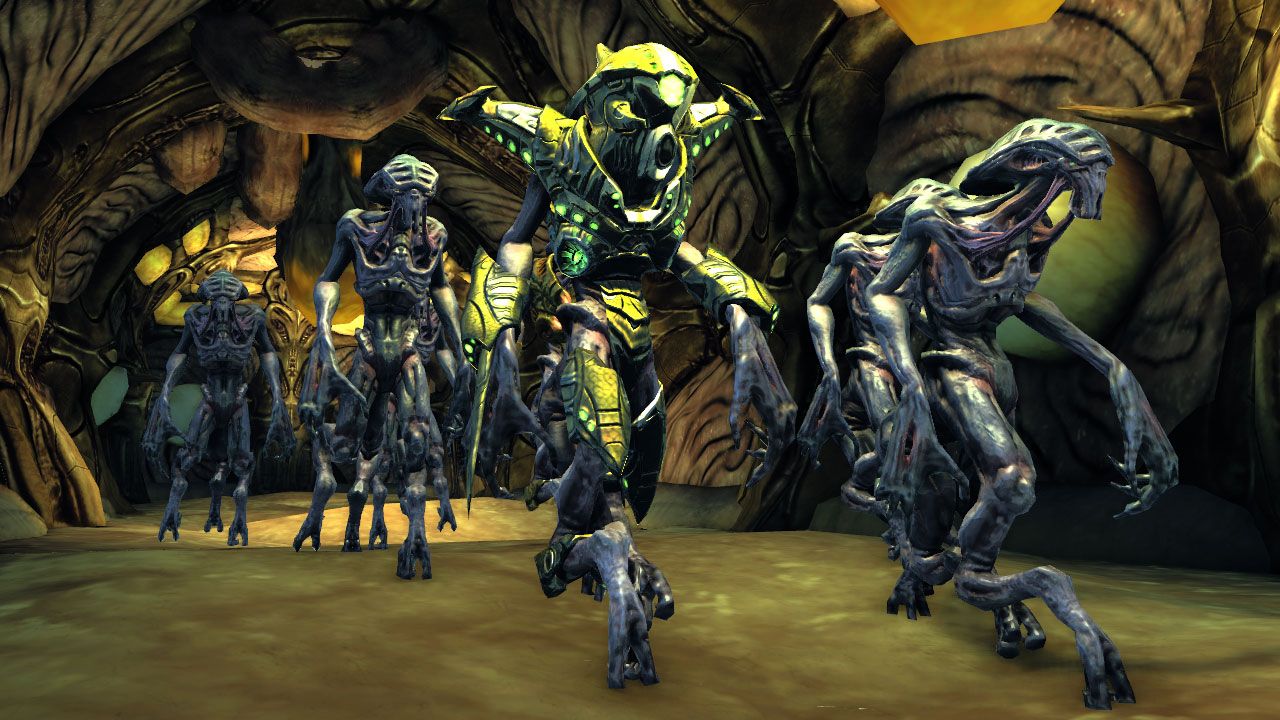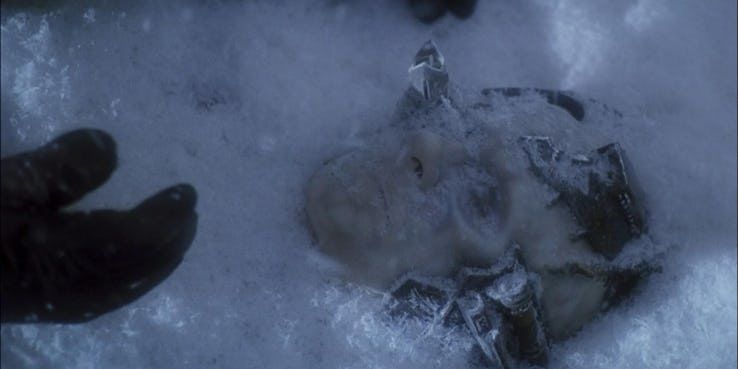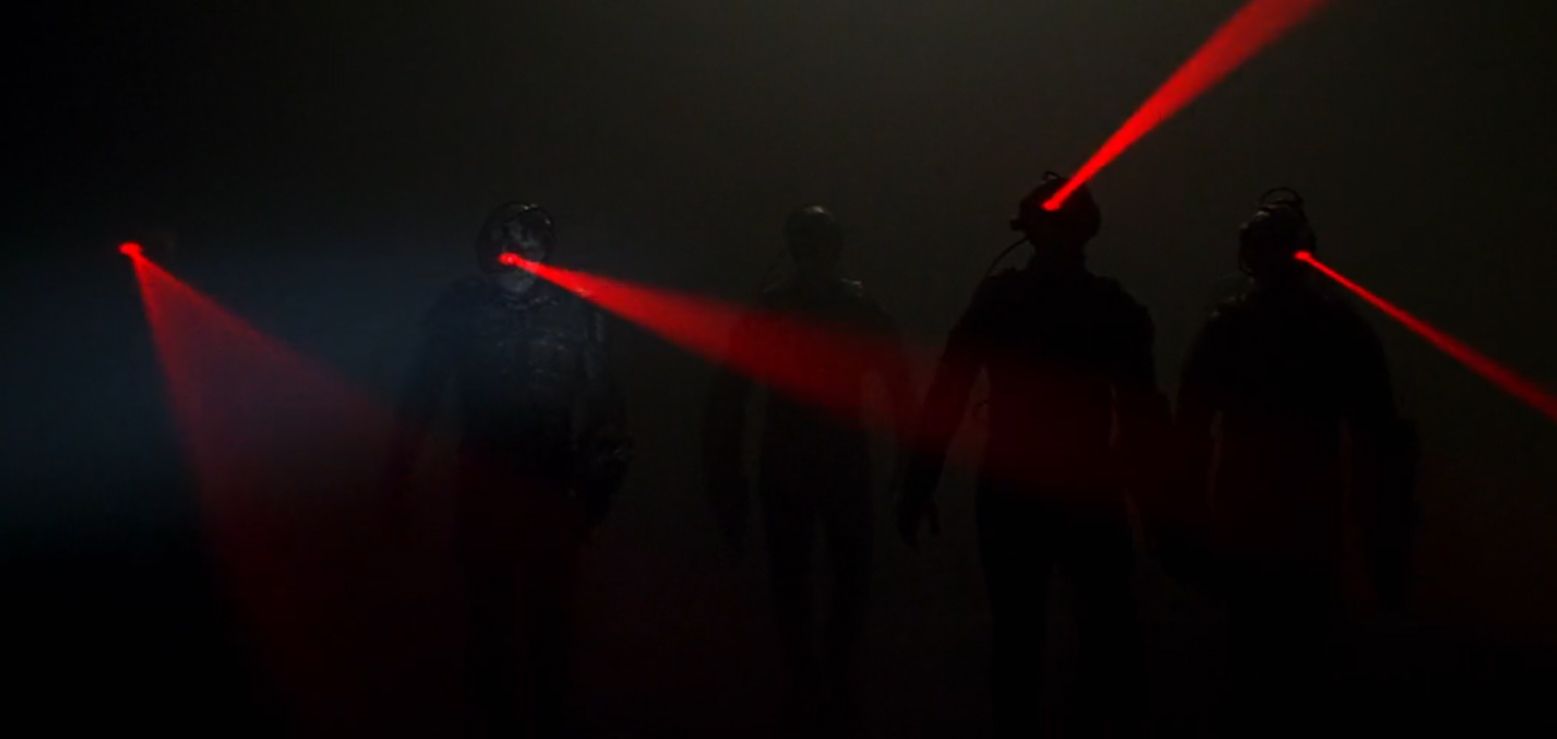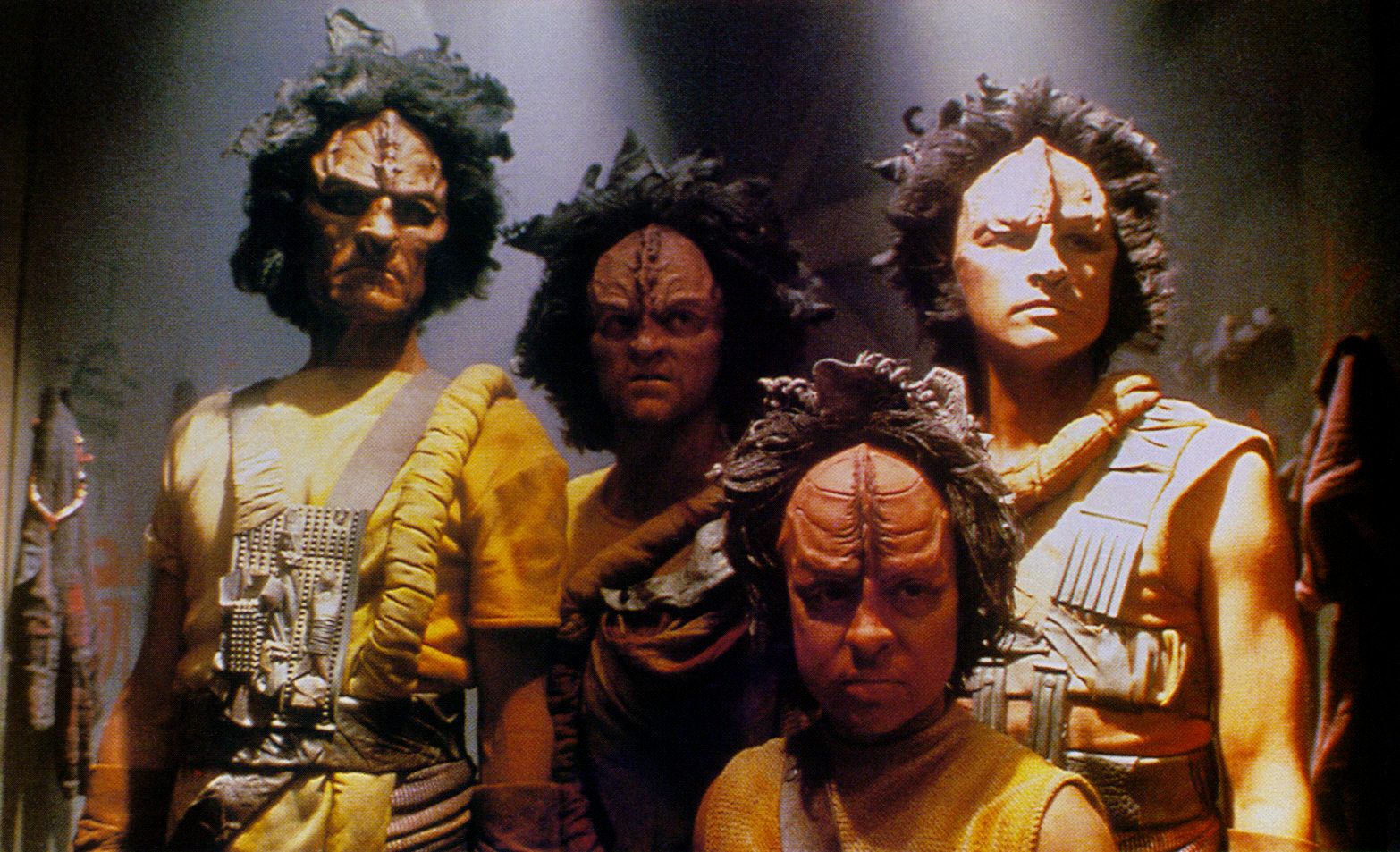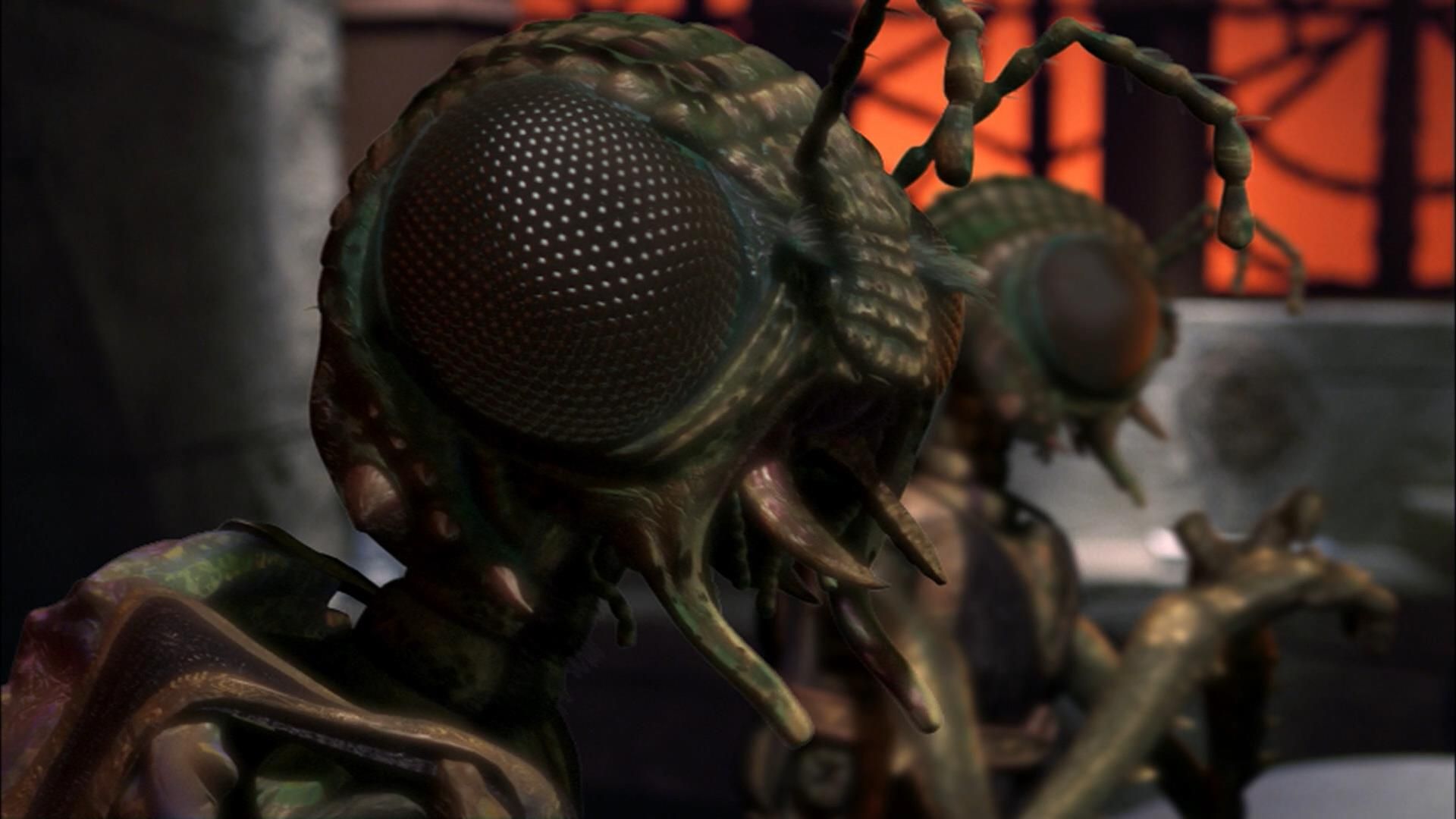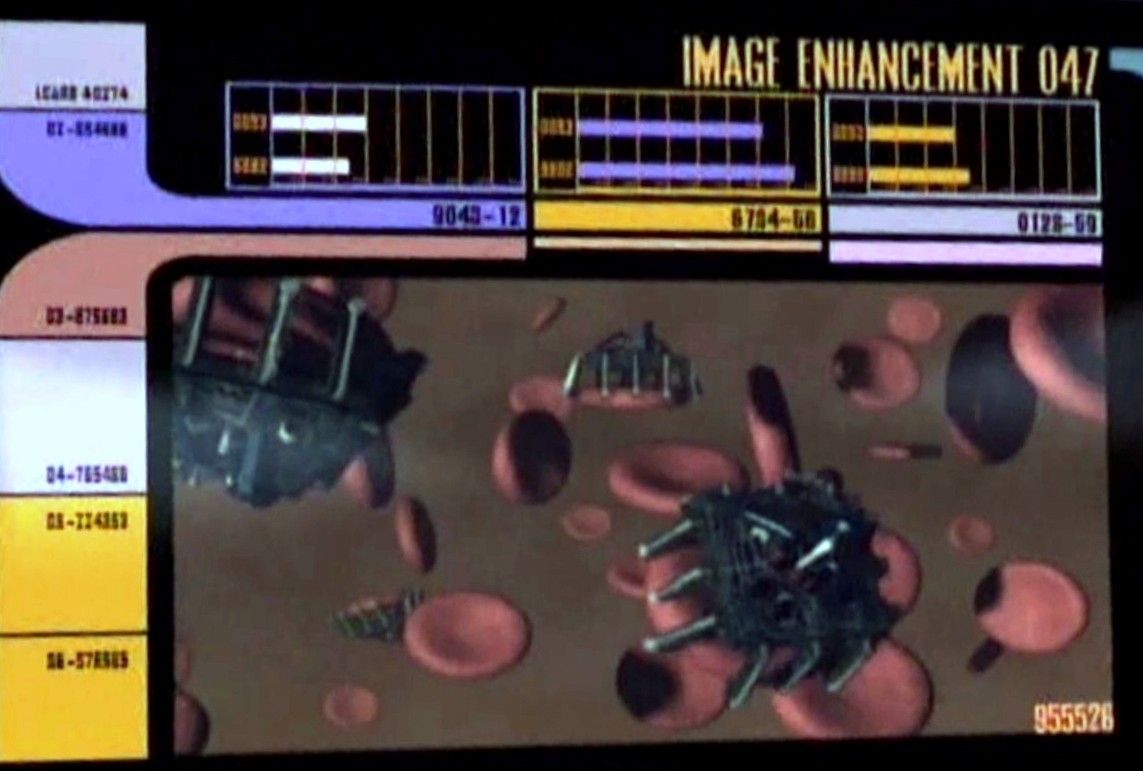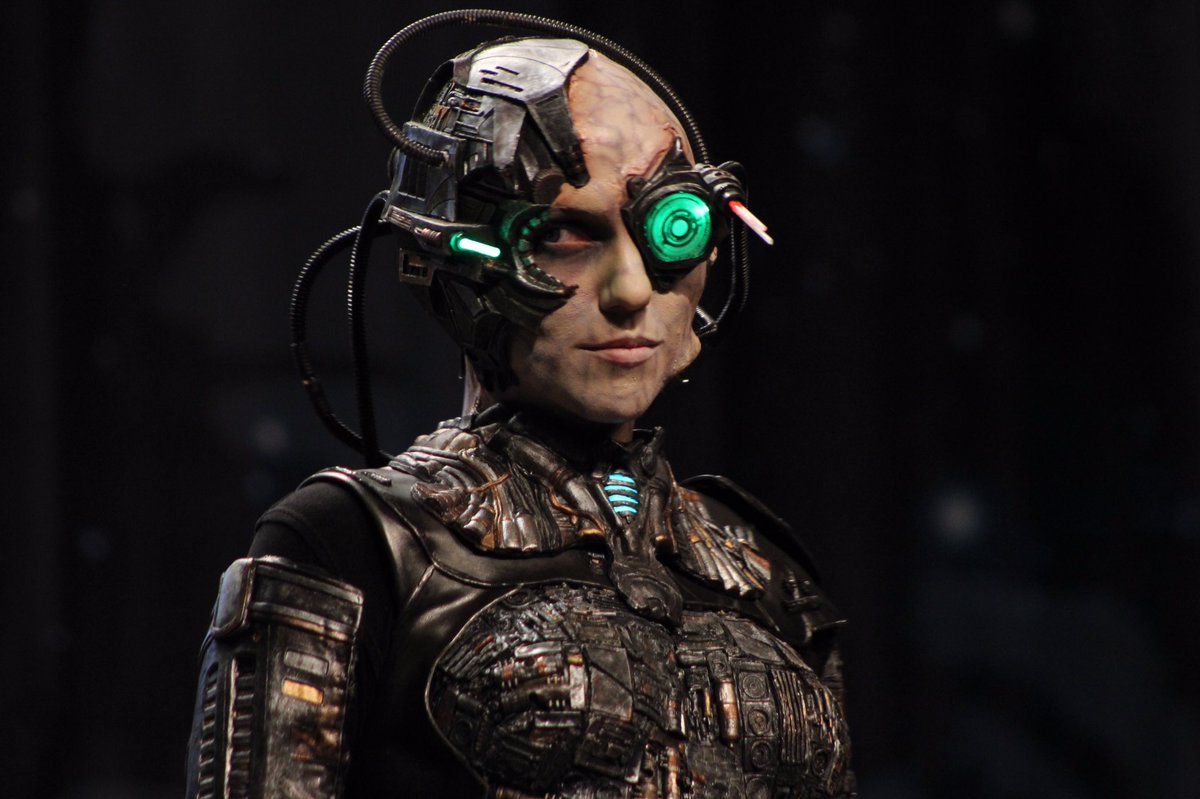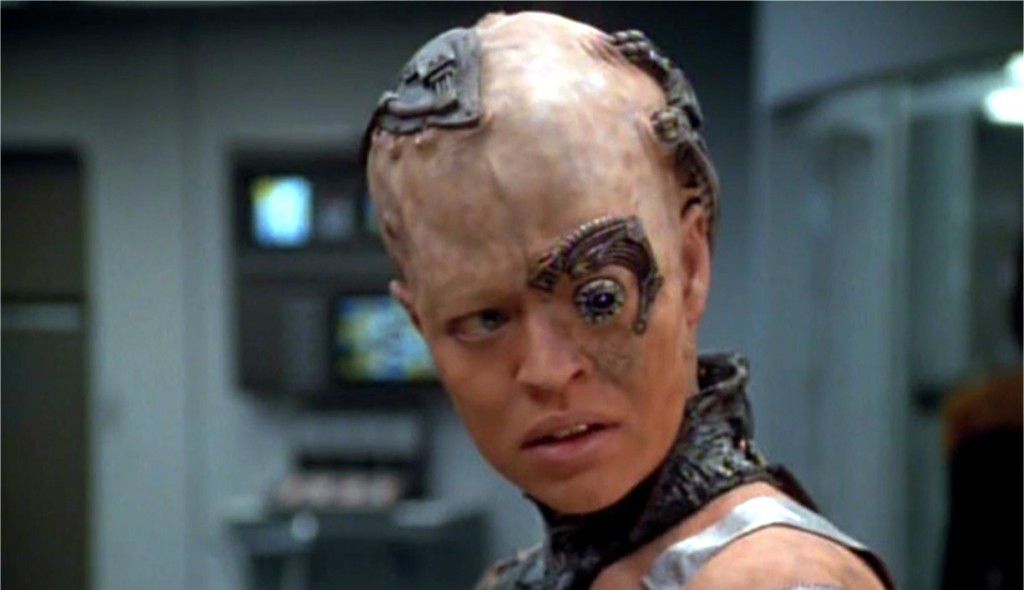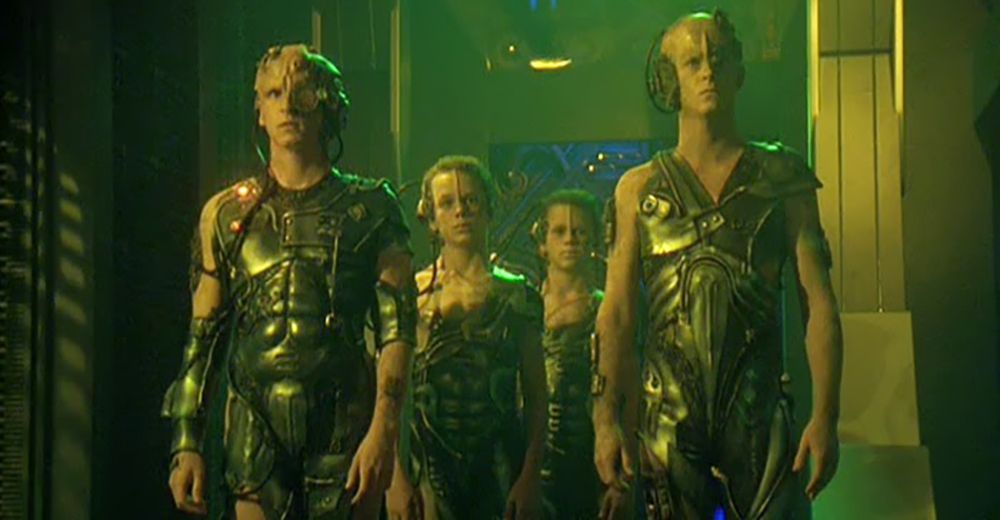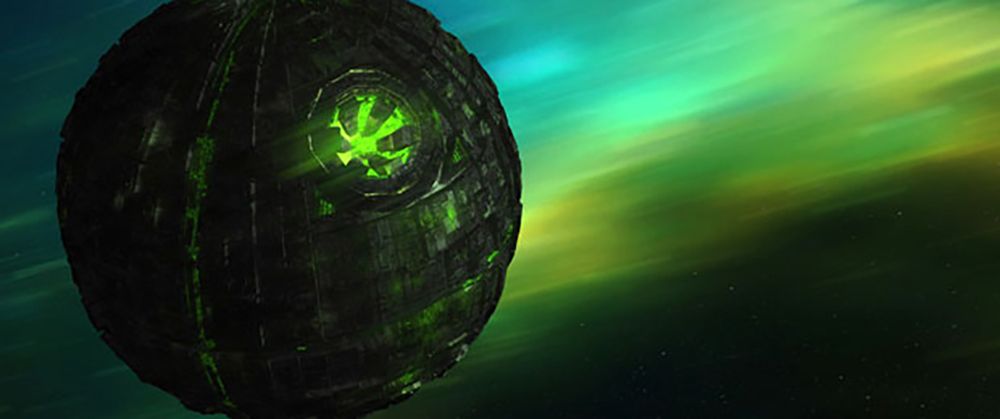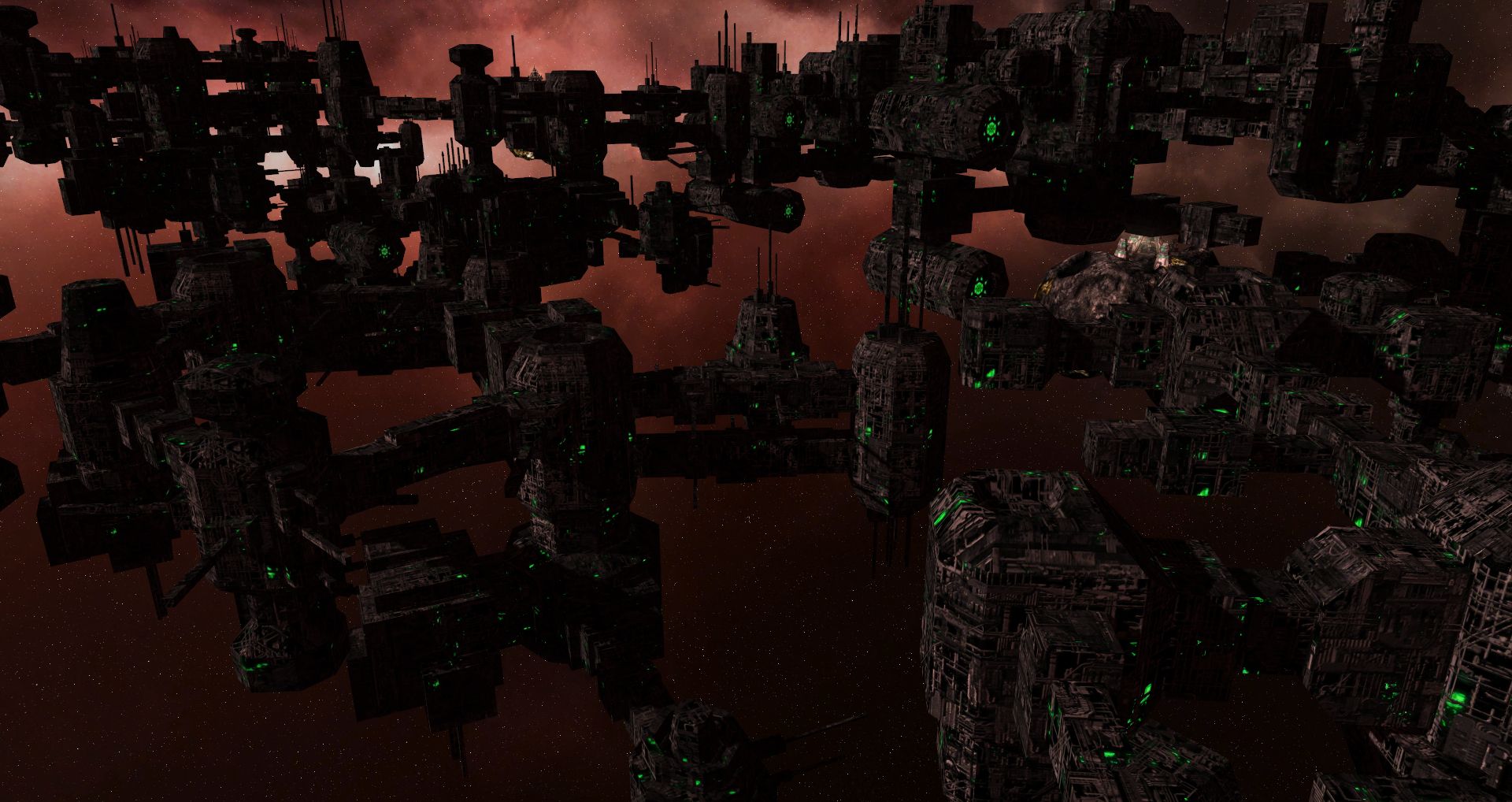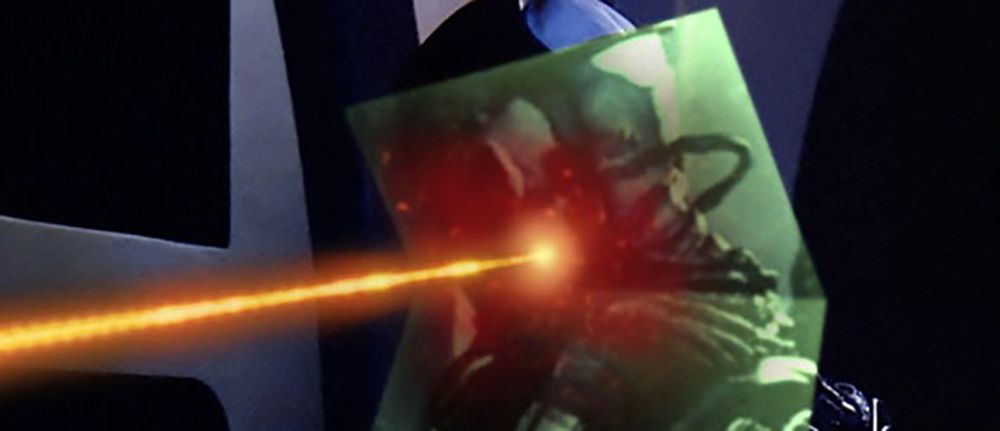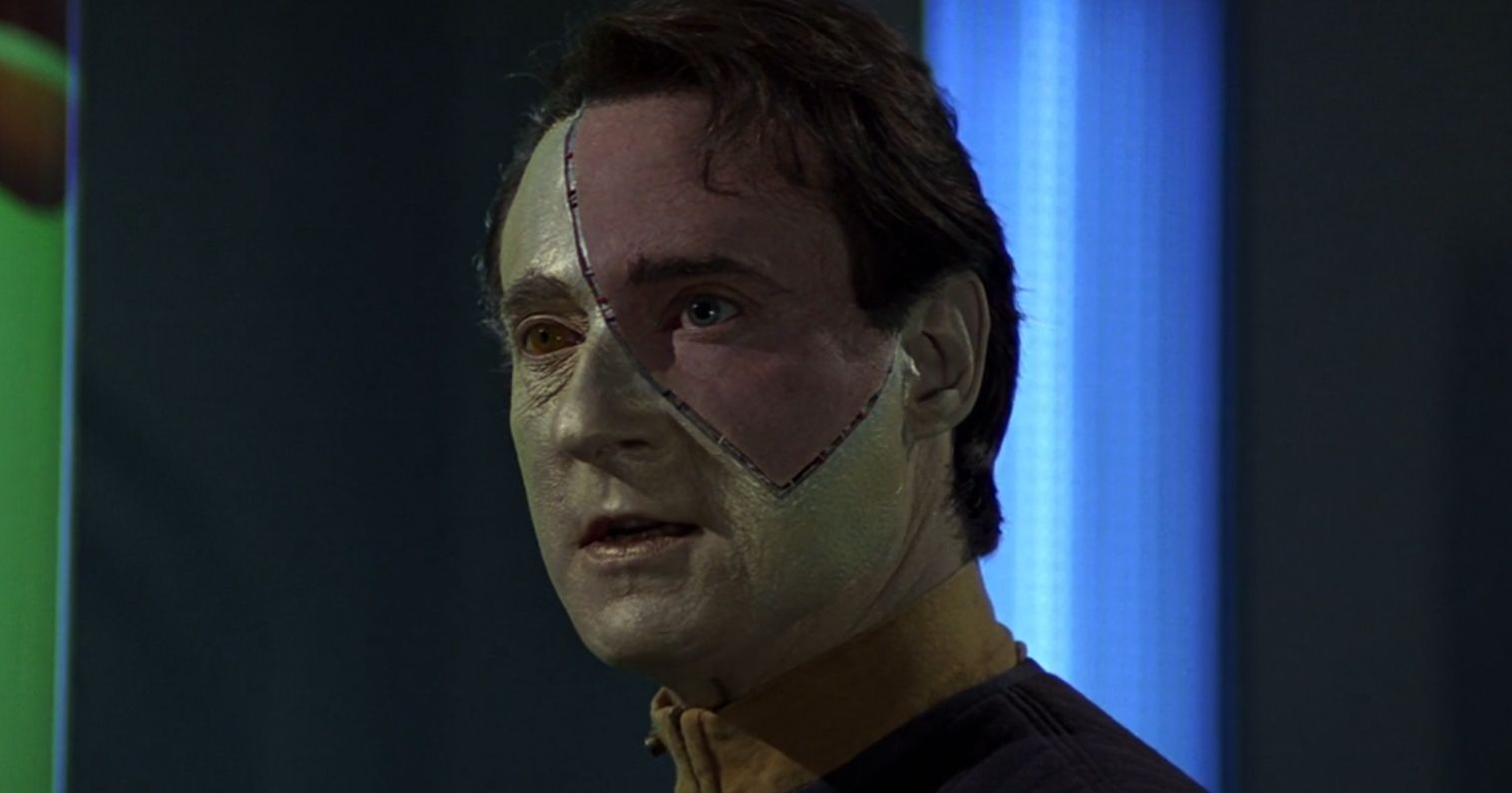Since the series first hit the airwaves on September 8, 1966, Star Trek has managed to create some incredible enemies for our heroes. Over the years, this creativity has resulted in species familiar to people who haven't even watched an episode, such as the Klingons, Romulans and the Cardassians just to name a few. While each of those species — and many more created over the previous 50+ years -- have their charms, none has quite struck a nerve like the Borg. The species was first introduced in Star Trek: The Next Generation and fans immediately recognized an enemy they could fear, themselves. These bad guys didn't just defeat and kill members of Starfleet, they assimilated them into their collective, which was much worse.
The Borg were presented as a wave, a force that couldn't be stopped by the seemingly advanced technology of the 24th century, but over the course of numerous television series, films, novels, video games and comic books, the Borg were able to be pushed back time and time again. Even though the Borg are one of Starfleet's greatest enemies in the 24th century and beyond, there still isn't much known about them. Series fans have certainly gleaned more details about them than casual fans over the years, but how much do you really know about the Borg... other than the fact that their name sounds Swedish? Well, you're about to find out!
20 ORIGINALLY MEANT TO BE THE BIG BAD
Star Trek: The Next Generation introduced a number of new enemies to the series, with the Borg being one of the most memorable. They never made it to become the series "Big Bad" but the showrunners did try to put them in that position a couple of times. This was due to the fact that the Ferengi, initially imagined to be the series' primary threat, fell flat and became more of a comic relief than anything else... could have had something to do with the big ears or their whip weapons, but that doesn't really matter any longer. The showrunners needed someone more fierce, which is why they turned to the Borg.
As any fan will tell you, the Borg were a threat, but not the main enemy of the series.
They were referred to before we ever saw them in the episode "The Neutral Zone" when the Enterprise found Federation and Romulan outposts, which were completely destroyed by an unknown enemy. This helped set the stage for a future Borg introduction, but when push came to shove, making the Borg the constant enemy of the Starship Enterprise didn't make sense. The main concept of the Borg revolves around their technological superiority and Starfleet's ineffectiveness in combating them. Were they do run afoul of the Borg in every other episode, but still defeat them and move on, it would have weakened the Borg's overall appeal.
19 ORIGINALLY, NOT CYBORGS
Most of the time, an alien race imagined for a series like Star Trek: The Next Generation undergoes a few changes before they make it to the screen. It's not uncommon for any Sci-Fi monster to look entirely different once makeup is actually applied. If you have any doubts, take a moment sometime and see what the Predator looked like before it hit the big screen. The Borg were originally planned to be an insectoid race, which would have changed who and what they were significantly. They were first proposed by writer Maurice Hurley as insectoid, but a significant problem stood in his way: it was 1987, and the CGI technology needed to render them believably was incredibly expensive and the budget simply wouldn't allow it.
While the effects teams weren't able to render his creatures the way he originally conceived, many of Hurley's ideas found their way onto the series. Like insects, the Borg operate as a hive with each drone dedicated to a specific task. They even operate under a queen, but that information wasn't revealed until years later. Further developments over the years expanded upon the nature of the Borg to better define the species, but many of the original insectoid concepts remained—even if they didn't manifest physically.
18 THEIR ORIGIN HASN'T BEEN FULLY ESTABLISHED
When the Borg were first introduced in the Star Trek: The Next Generation episode "Q Who," members of the away mission to the Borg cube found they were able to walk around freely on the ship. This turned out to be due to the Borg not fearing them and only attacking when presented with a threat. While they were walking around, Commander Riker and his team discovered a Borg nursery filled with infants. Each of these children had the cutest, little Borg implants stuck to them, which suggested their origin. "From the look of it the Borg are born as biological lifeforms. It seems that almost immediately after birth they begin artificial implants."
This origin was fine at the time and fans accepted it, but since that first appearance, more information has been released.
On Star Trek: Voyager, it was revealed that the Borg do not reproduce at all. Instead, they assimilate other species and place the youth into what was called a "Borg Maturation Chamber," a device used to accelerate the aging of the subject and make them into Drones. Additionally, Q informed Captain Picard that the Borg's interests lay only in Starfleet's technology, but as their information was expanded, it became apparent the Borg were definitely interested in their biology as well. Ultimately, the true origin of the Borg has never been fully fleshed out, which does add mystery to the species.
17 THEY CAN THINK FOR THEMSELVES
The Borg are a Collective, which means they don't have any individuals when it comes to the trillions of Drones spread throughout the galaxy. Drones are linked into the hive mind such that they are always in constant contact with every other Drone. The original thoughts, feelings and memories of each individual spread about from one Drone to the next. This is one of the main reasons they are such a powerful enemy. They don't need to stop and think to do something and if a Drone is near a power junction and needs to fix it but doesn't have the knowledge or skill in doing so, they can simply tap into their collective consciousness and immediately know what to do. This is the way they are presented throughout most of the series, but it was later revealed Drones retained their own thoughts.
In the Star Trek: The Next Generation episode "I Borg," the crew of the Enterprise stumble upon an injured Drone and return him to the ship for medical attention. The Drone initially has difficulty being detached from the Collective as he is no longer able to hear the thoughts of millions of others in his head. Over time, he began to accept his individuality and took the name Hugh, even referring to himself as "I," which is something a Drone would never do. He was later returned to the Collective where his newfound individuality wreaked havoc throughout his cube.
16 NOT ALL BORG ARE DRONES
When they first were presented, it appeared that no Borg was an individual. Their designations refer to their placement in a group and are, by no means, the equivalent of a name. It was surprising when Captain Picard was captured and assimilated by the Borg in the episode "The Best of Both Worlds" when he presented himself with the name, Locutus of Borg. He later referred to himself as "I" and acted as an individual on behalf of the Collective. It was revealed that the reason for his unique assimilation was to help transition Starfleet into the Collective with as few casualties on either side as possible.
In Star Trek: First Contact, the Borg Queen revealed she had ulterior motives and a romantic relationship was not so subtly implied.
Picard/Locutus wasn't the only one to receive the "Borg Ambassador" treatment throughout the series. On Star Trek: Voyager, Captain Janeway is also assimilated, though she is initially made into a Drone. When the Queen establishes contact with her, Janeway is still an individual thanks to a neural inhibitor so the Queen sends Janeway to Voyager via their hologram system to try and broker a deal. Ultimately, she is rescued from the Collective alongside B'Elanna Torres and Tuvok while simultaneously delivering a crippling blow to the Borg, but the episode did show the Queen's preference to turning Starfleet Captains into ambassadors... of a sort.
15 THE BORG HAVE A QUEEN
For anyone who saw Star Trek: First Contact, you already know the Borg have a queen, but it isn't as simple as what was presented in the film. With this introduction, the relation between the Borg and an insect colony was further clarified, but unlike a hive of insects, the Borg Queen appears to exist in more than one place at a time. Her true origins are unknown and across her numerous appearances on Star Trek: Voyager, her story unfolded only a little bit. When she first appeared on Star Trek: First Contact, she identified herself by saying, "I am the beginning, the end, the one who is many. I am the Borg." She further defined her role as bringing order to chaos and while she called the Borg "my drones," she doesn't present exactly as an individual.
On an episode of Star Trek: Voyager called "Unimatrix Zero, Part II," the Queen revealed she had been assimilated around the age of seven or eight alongside her parents, but gave no insight as to how she became what she was. There have also been insinuations that a Borg Queen exists on every Borg cube, but this hasn't been confirmed. Each depiction of the Borg Queen is identical, suggesting she may be a clone of an original assimilated person, but this too remains unconfirmed. What we do know is that her main function is to coordinate the drones in the hive, much like a queen in an insect colony.
14 THEY ASSIMILATE EVERY ASPECT OF A SPECIES
The Borg are very clear about their intentions when they meet up with an unsuspecting starship or colony. Upon making contact, they broadcast the following message, "We are the Borg. Existence, as you know it, is over. We will add your biological and technological distinctiveness to our own." The last sentence is pretty specific in what their goals are. They won't only assimilate a species' biology, but also their technology, and while it isn't specifically referenced, they also assimilate the culture, history and every other aspect of a species when they bring them into the Collective. This was fleshed out over numerous episodes thanks to Seven of Nine's comments on Star Trek: Voyager.
Nothing is discarded no matter how trivial it may appear.
In a number of episodes, Seven mentions specific species by their Borg designations and reveals information about those species. These revelations aren't solely related to the species' technology or their biology, but have, at times, referenced their burial rights and belief in the afterlife as well as other aspects of a culture previously believed to be unimportant to the Borg. It is later revealed that the entire memories of those assimilated as well as the memory on their computer systems is brought into the collective and shared — nothing is discarded no matter how trivial it may appear. In some ways, this means that any culture destroyed by the Borg continues to exist across their Collective memory.
13 THEY FEAR ONLY ONE SPECIES
Species 8472 is the designation given by the Borg to a species of non-humanoid aliens who come from a dimension called "Fluidic Space." The species is technologically superior to the Borg and when they are first introduced, they are seen to be wiping out dozens of Borg cubes with little to no effort. Not only do they outgun the Borg with their superior technology, the species cannot be assimilated into the Collective, which leaves their unique biology and technology forever out of the Borg's hands. They became a major problem for the Borg, which was only overcome thanks to Captain Janeway and her intrepid crew. The Doctor derived a means of combating them via a bio-molecular warhead their bio-ships were susceptible to.
In an unprecedented move, Janeway bartered with the Borg so she could cross their territory. She gave them access to the weapon and they allowed her safe passage. Species 8472 retreated to their dimension, but appeared in a later episode where they were shown to possess the ability to shapeshift. They did so by altering themselves into members of Starfleet — even going so far as to create a mock Starfleet Headquarters to help them better understand their enemy. Ultimately, Voyager and her crew stumble upon the training facility in deep space and made contact. Species 8472 blamed Starfleet for handing the weapon to the Borg, but they ultimately come to an understanding.
12 THEY DISCOVERED HUMANITY MUCH EARLIER
Star Trek has never shied away from using time travel as a plot device, even going so far as to make it into the movies. When it comes to creating a prequel series like Enterprise, which needed to introduce some villains into a universe canon had previously established to be relatively devoid of any enemies up to that point, time travel came in handy. The main premise of Star Trek: First Contact involved the Borg vessel travelling back in time to disrupt Earth's first contact with the Vulcans and enable them to send the details of Earth's location to the Borg of that time.
This would enable the assimilation of Earth prior to the creation of Starfleet and effectively wipe out the main opposition to the Borg in the Alpha Quadrant.
In an episode of Enterprise, Captain Archer finds some of the Drones who had been sent back in time frozen in the Arctic. It turns out these Drones had been separated during the events of First Contact and once they were revived, they began to assimilate the scientists who discovered them. While he was interested in discovering a new species, Archer ended up having to destroy the Drones. You might think this information would have made its way to Starfleet and eventually to Captain Picard, but thanks to Archer's inability to name the species, the record never arose as being related to the Borg when the Enterprise-D made first contact.
11 THEIR COSTUMES HID SECRETS
If you look closely enough at the Borg in any version of Star Trek, you might notice their costumes look somewhat clunky and antiquated. This is due to the fact that the costume designers grabbed old circuit boards and hoses to throw the costumes together and make them into something that resembled both technology and biology. While they were at it, they went ahead and included some fun Easter Eggs and personalized messages meant just for the cast and crew. Jake Garber, the makeup artist responsible for the Borg costumes on First Contact, wrote the names of other makeup artists on the Borg accessories spread all over their costumes. These couldn't be seen by the cameras, but they were there.
On one costume, Michael Westmore, another artist working on the film, wrote "Westmore's House of BBQ" on a Borg, which somewhat takes away from the intimidation factor, but shows the lighter side of the crew working on the film. Westmore's son was responsible for wiring the LEDs seen on each Borg eyepiece and he had a little fun with these as well. The red lights would blink in Morse Code to send secret messages to any eagle-eyed fans watching. Some of these spelled out the names of the crew while one spelled out "Bonnie," which was the name of his dog.
10 THEY CHOOSE NOT TO ASSIMILATE ALL SPECIES
You might think that every species the Borg comes into contact with is assimilated, but it turns out they are far more discerning than previously believed. The goal of the Borg was not simply to acquire whatever knowledge, biology and technology they could find, but to add it to their collective with the goal of becoming a perfect race. For this reason, they wouldn't always assimilate another species. When the Borg made contact with the Kazon (pictured), they designated them Species 329, but determined they were unremarkable and that adding their "biological and technological distinctiveness" to the Collective would detract from their perfection.
This was later clarified throughout Star Trek: Voyager when it became apparent some species were assimilated when they showed a technological prowess in Warp travel.
When the Borg detected a Warp-capable civilization, they would likely assimilate them if they achieved an unspecified speed. The Kazon were technologically inferior, though they were a Warp-capable species. They lacked other technologies such as transporters and holographic displays, which may have been the reason the Borg disregarded them... for now. There were no other species explicitly described as undesirable for assimilation, but there was no evidence of the Borg assimilating pre-Warp civilizations suggesting their primary interest is technology over biology.
9 THEY CAN'T ASSIMILATE ALL SPECIES
As previously mentioned, the Borg cannot assimilate Species 8472, though this is not the only species they cannot assimilate. The main component of any Drone is the humanoid body used to house the cybernetic implants used to connect a Drone to the Collective. This establishes that the Borg cannot or will not assimilate species who do not have humanoid bodies. If you look back through the comics, books, films and television series showing the Borg, every example of a Drone is clearly derived from a humanoid species. There's a long-running joke about how every species in the Star Trek universe is humanoid, many of whom look exactly like humans, but this was explained in the Next Generation episode "The Chase" as being the result of intentional panspermia.
Regardless of the readily-available number of humanoid species for the Borg to assimilate, there are countless others who are not humanoid. In addition to gaseous entities, photonic beings, crystalline species and other non-corporal beings, there are insectoid races such as the Xindi who are exempt from assimilation. The Xindi have shown a technological superiority, which would certainly benefit the Borg Collective were they assimilated, but there is no evidence they have ever been brought into the hive. The Borg's reasons for keeping non-humanoids out of the Collective could be the result of incompatibility or it could simply be too energy-costly to adapt their systems to allow for the transition. Whatever the reason, there are plenty of species in the galaxy who have little to fear from the Borg.
8 ASSIMILATION STARTS VIA INJECTED NANITES
There are a number of steps that go into turning a sentient being into a Borg Drone, but the first involves injecting Borg Nanites into the bloodstream. This is done via two hose-like devices on the back of the hand, which are forced into the neck of an unsuspecting victim. For most of the series, this was the main way the Borg assimilated someone: up close and personal. There have been indications the Borg can assimilate via an airborne nanite cloud, but this isn't expressly fleshed out in canon, though it is generally accepted to be the case when the Borg need to assimilate an entire species. Once the nanites enter a person's bloodstream, they immediately go about converting organic tissue into the various cybernetic parts needed to integrate a Drone into the Collective.
Once a person has succumbed to the nanites, which only take a few minutes, they are taken to assimilation chambers aboard Borg ships for further processing.
Limbs are removed and replaced and the body is covered in a mesh-like armored exosuit. While all Borg Drones have a similar appearance, no two Borg are exactly alike (except for the Queen). Different tools are given to each Borg depending on what their purpose is in the Collective.
7 ALMOST ALL BORG HAVE AN EYE REPLACED
You may look at a Borg Drone and think their various attachments and alterations are simply the cost of being a Borg, but there is one aspect of Borg physiology that remains a near constant and that is the ocular implant. Almost all Borgs, or at the very least, the Borg who aren't assimilated people from the main cast, have an eye replaced with a device called an ocular implant. These implants provide a variety of enhancements, which have been explored throughout the series, books, comics and films. Nearly all Borg ocular implants look a little different from one another, which helps to establish the dissimilarities between Borg costumes, but they all preform pretty much the same functions.
Primarily, an ocular implant enhances the vision for the Borg drone in such a way as to make them superior to normal vision. It has been demonstrated that each Drone is capable of seeing in enhanced clarity while viewing objects. This is further refined to allow for a complex analysis of three-dimensional shapes via ocular magnification down to the microscopic level. Additionally, an ocular implant can perceive objects that exist across the space-time barrier to see things "out of phase" with reality. The Borg Queen has also shown an ability to tap into the ocular implant of any of her Drones to see what they see, albeit in a green tint all implants operate in.
6 THEIR ALTERATIONS RUN DEEP
Looking at a Drone, you will see that they might have an arm replaced and an ocular implant, but many of the modifications don't seem to dig much deeper than that. Their exosuit/body armor doesn't exactly look like clothing, but it also doesn't appear to be grafted onto the skin and while no Drone has any body hair, they generally seem to be modified only slightly from their original, unassimilated appearance. When the character Seven of Nine was introduced on Star Trek: Voyager, we got to see just how deeply the Borg cybernetic implants went and it is much worse than you might have thought.
Seven's ocular implant isn't just a replacement of her eye, it encompasses most of her skull.
Scenes where the back of her head are visible show mechanical protrusions throughout. In a later episode where she begins to reject her implants, tears in her skin show what's really going under the surface and it's all cybernetic just below the skin. Very little organic tissue appears to remain intact following a complete assimilation, which is one of the reasons Seven continues to require regeneration in her Borg alcove instead of simply getting some shuteye to finish up her day.
5 A DEFECTIVE DRONE IS ALWAYS DISCARDED
The Borg operate in such a way as to strive for perfection, which means they don't have much of a tolerance for defective parts. Parts, in this instance refers to Drones. When one Drone becomes damaged, it may be simpler to salvage the parts from it than to attempt reviving it and returning it to the collective. This has been demonstrated in a number of episodes of Star Trek: Voyager when Seven's parents were on a ship observing some Drones. They noted that a damaged Drone was scrapped for parts rather than repaired or healed in any way. When a Drone is infected or altered in some way by an outside force, they are removed from the collective and left to fend for themselves. This happened to a number of children (pictured) who made their way onto Voyager after being severed from the Borg whole.
The children were released from their Maturation Chambers prematurely and were considered defective by the Collective. This resulted in their removal from the hive mind, which would have eventually driven them insane, but they were rescued by Voyager with the help of Seven of Nine. Once their individuality began to reassert itself, they were able to make the transition back to their former selves with the help of Seven and the Doctor who removed most of their Borg implants.
4 MORE THAN JUST CUBES
When the Borg first came onto the scene, they showed up in a gigantic cube. This was an interesting design choice for a sci-fi series because, even though starships require absolutely no aerodynamic designs, they almost always featured a sleek look as if they could cruise through the air. When you think about it, this doesn't make sense. Why not use a shape that allows for maximum use of space rather than a sleek design? A Borg cube measures over three kilometers along a single size, giving it an internal volume of 28 cubic kilometers. Nothing in Starfleet comes anywhere close to that.
Of course, the cube wasn't the only geometric shape the Borg designed for their starships.
In addition to the cubes, they have spheres and even diamond-shaped spacecraft. The Sphere is often used as a long-range tactical vessel or scout vehicle measuring 600 meters in diameter with a crew of 11,000 Drones. They were either launched from within a Borg cube or operated independently, and while they aren't as massive as the cubes, they are devastatingly powerful spacecraft capable of Trans-Warp and even time-travel as demonstrated in Star Trek: First Contact. There are different classes of Borg ships including tactical versions of the cube, which are heavily armored and there also exists a special octahedron-shaped ship used by the Borg Queen.
3 THEY HAVE A HOMEWORLD... OF SORTS
The origins of the Borg are deeply shrouded in mystery, and while they likely originated on a planet somewhere as Species 001, where that planet may be and what the people originally looked like remains unknown. What we do know now is that the Borg do operate out of what appears to be a central hub of interconnected structures in space called the Unicomplex. The Unicomplex spanned more than 600 kilometers, maintained hundreds of Borg vessels and housed trillions of Drones. It was also considered to be the home of the Borg Queen. This is somewhat confusing given her presence elsewhere throughout the various series, but she maintained a permanent presence on the Unicomplex in one form or another.
The Unicomplex is a formidable structure and the closest thing we have seen that could be considered a Borg Capitol, but it may not be the only one. We never saw more than a single Unicomplex, but the one we have seen may only be the main Unicomplex. On the Star Trek: Voyager episode "Unimatrix Zero, Part II," a Borg Drone, Axum, described it as the "Primary Unicopmplex," which suggests there is more than one of them. Regardless if there are more, the one we are shown on Voyager is likely the largest and most dangerous one to visit, so you know Captain Janeway directly attacked it at least once. She totally did.
2 THE BORG ADAPT TO ANY SITUATION
One of the biggest problems any member of Starfleet has had while combating the Borg is their quick ability to adapt. It is a well known fact that Borg Drones are able to create a defensive shield against Phaser fire, which often results in their ability to only take down one or two Drones before the ever familiar phrase, "They've adapted" can be uttered by someone holding a Phaser rifle. It isn't just their ability to adapt technical responses to threats that makes the Borg such a devastating foe either.
Like their shields, they are able to repair nearly anything in short order due to their ability to adapt and overcome.
Throughout her time on Voyager, Seven of Nine often said something to the effect of "I am Borg. I will adapt." She used phrases like this to describe overcoming any obstacle she faced or when describing other members of the Collective. Adaptation is how the Borg advance themselves collectively as a species; they either do this by assimilating other species or by modifying themselves and their technology. The most difficult foe to beat isn't going to be the one who remains predictable and who never changes; the toughest foes are always the ones who adapt and evolve to suit any situation and that's exactly what the Borg do whenever they engage Starfleet.
1 DON'T BELIEVE THE HYPE: RESISTANCE ISN'T FUTILE
The Borg have a saying, "Resistance is futile." It's one of those things they like to throw in there to let their prey know they have no chance in defeating them. When you consider the thousands of species who have fallen to the Collective, they do have a point, but you really shouldn't believe the hype. In every instance, the Borg took on the main cast and crew of a Star Trek franchise, resistance always proved to be anything but futile. Captain Picard proved this on multiple occasions and Data showed just how effective resistance could be when he took out the Borg Queen in Star Trek: First Contact.
The Starfleet Captain who best demonstrated a refusal to accept the phrase was Captain Janeway. Not only did she approach and negotiate with the Borg, she attacked them directly on more than one occasion... and this was a Captain who had been cut off from Starfleet for years. She directly battled the Borg Queen and resisted her Drones on every occasion. The Borg should probably change their favorite saying from "Resistance is futile" to "Resistance is futile, but if Catherine Janeway is on your vessel, please continue on with our compliments." It would probably serve them better in the long run.

